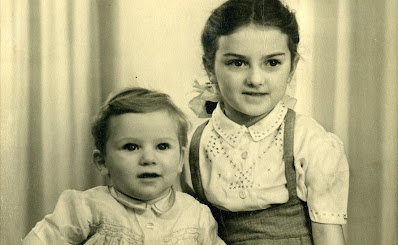This week's Sepia Saturday prompt photograph features a young girl c.1920s wearing a short pleated skirt with straps.
This immediately brought back memories of my childhood clothes in the 1950s. My mother, Kathleen Weston, nee Danson was a dressmaker, apprenticed to a tailor at the age of 14, so my Sunday coats always had velvet collars, embroidered with flowers and a matching bonnet, and my "best" dresses usually had smocking.
The uniform at my High school for the first two years was such a skirt with straps, made by a local firm called "Windsor Woolies" I could not see any respecting modern twelve year old putting up with that style today. I was about 13 before I "graduated" to a grown up skirt.

My brother and I in 1948. See the Peter Pan collars, smocking on his baby top and the cross stitching on my blouse - all my mother's handiwork.
I grew up in north west England where winters were relatively mild, but this was the days before tights and girls then did not wear trousers. Boys were stuck in short trousers until the milestone of their voices breaking. I have no winter photographs of my childhood - the camera must have been reserved for summer only.
But the ritual dress for going out in winter in my early 1950's was - A
Liberty bodice (a fleeced form of underwear) over my vest, a pleated skirt with straps, worn with short socks, home knitted
jumpers and a pixie hood, Wellington boots, gloves kept safe on a
string through my coat sleeves, plus a long scarf criss-crossed over my
chest and tied at the back. I hated Liberty bodices - the rubber buttons
were difficult to fasten and undo, and if the day got warmer, you ended
up all sticky inside them.
Both
my mother and aunt kept me in hand knitted jumpers and cardigans,
though I remember being less than pleased around the age of 8 to open a
Christmas present and realise it was a jumper - not a toy. A winter
occupation was to help my mother unravel old knitwear and wind up the
balls of wool for re-knitting. This was still the postwar era of "make do and mend".
 |
| Summer c.1950 |
Mum always made me a new sundress for holidays, with a matching little bolero jacket. The one in the picture (right) was green and white - she was very fond of putting me in green and it still features a lot in my wardrobe today. Dresses were often gingham, with white Peter Pan collars and the standard footwear was a pair of brown Clark's sandals with the cut-out flower.
Other memories into the 60's were of shirt waister dresses, pinafore dresses, plastic macs, awful plastic hoods called rainmates, baby doll pyjamas - and summer duster coats. Why were they so called, as I could not see women dusting the furniture in them. Apparently they originated from loose garments worn to protect clothes when driving in early open-topped motor cars.
When I started university, the first thing I bought from my grant was a hooded duffle coat to dress the part of a 1960's student.
 |
| I liked wearing pinafore dresses and had a variety of colours in my wardrobe - here photographed against Inverary Castle, ancestral home of the Campbell clan in west Scotland, 1971. |

Sepia Saturday gives an opportunity for genealogy bloggers




Quite the fashion show, though I think we US folks may have had some different names for some of your pretty outfits. I could figure out most of what nicely made things were...I also wore lots of "made by my seamstress grandmother" clothes.
ReplyDeleteA fine array of fashions from the '40s into the '70s. I don't remember, nor do I have any pictures of myself wearing a skirt with straps until I was a pompom girl in my senior year in high school. But I remember all the pretty dresses my Grandma Louise made for me and my sisters every year. My Mom also sewed up some pretty items for us to wear and she's the one who taught me how to sew which opened a whole new world! :)
ReplyDeleteA fine medley of fashion history. Every time I read your posts about clothing I realize I don't have any useful vocabulary of textiles, garment parts, or sewing techniques. Even with fashions of my own time I feel deficient in descriptor words. Fortunately Wikipedia provides guides with pictures but it's not always easy to recognize detail differences in what people in old photos are wearing. That's why I like reading your blog to get pointers on what things were called. I hope you do more.
ReplyDeleteI had skirts like that in my 1950's childhood too :)
ReplyDeleteThank you all for your kind comments. Ye, the respective name for clothes gets confusing between British terminology and American. Our jumpers you call sweaters; our pinafore dresses are your jumpers (I think). Our waistcoats are yolur vests which to us are underwear. I have to stop and think when I read in American novels of a girl going out in "red pants" - that conjures up quite a picture as to us "pants" (or panties) are our undergarments i.e knickers - not trousers.
ReplyDelete